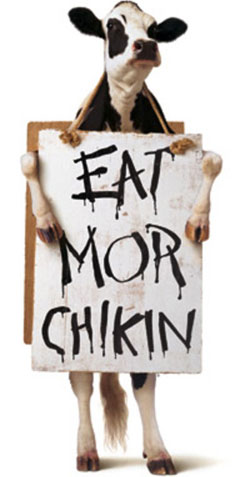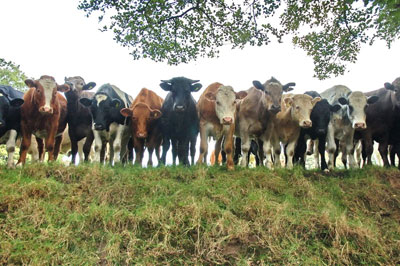Amazing Cow Facts
 A cow is a mature female and is a member of the bovine family.
A cow is a mature female and is a member of the bovine family.- The male counterpart of a cow is called bull and the offspring is known as a calf.
- A heifer is a young female cow that hasn't had a calf yet. A cow gives milk for the first time, only after she gives birth to a calf.
- Cattle is the name for the entire "cow" family.
- A cow can climb up the stairs, but cannot climb down. This is because her knees cannot bend properly. Source1 Here is a company that will teach cows to walk down stairs.
- Cows don’t bite because they have no upper front teeth. Instead they have a thick, tough pad of skin on their top jaw. They curl their very large tongue around the grass and feed they eat.
- Modern domestic cattle are believed to belong to either the species, Bos taurus (Holstein, Brown Swiss, Jersey and Guemsey), or the species, Bos indicus (humped cattle like the Brahman). Some cattle are a cross between the two species.
- There are about 920 different breeds of cows in the world. Cows were domesticated about 5,000 years ago.
- Cows came to America with the Pilgrims. They arrived in the Jamestown colony in 1611.
- Humans and cows have the same gestation period which is about nine months.
- Milk contains 4 necessary minerals: calcium, phosphorus, magnesium and zinc.
- The smallest type of cow is a breed called Dexter, which was bred a small size for household living.
- Cows can see color.
- Cows can detect odors up to 5 miles away.
- A cow's heart beats between 60 and 70 beats per minute.
- Cows can hear lower and higher frequencies better than humans.
- Cows are very social animals. They form large herds and just like people, they will bond to some herd members while avoiding others.
- They "moo" and use different body positions and facial expressions to communicate with each other
- A Holstein's spots are like a fingerprint. No two cows have exactly the same pattern of black spots on their white body.
- Cows can live 25 years. You can guess the age of a cow that has horns by counting the number of rings on the horns. Before counting, make sure the horns belong to a cow.
- A cow stands up and sits down about 14 times a day.
- A cow produces around 200,000 glasses of milk in her lifetime.
- The record milk production for a single cow in a year is 55,660 pounds of milk.
- It takes about 350 squirts for each gallon of milk from a cow.
- A 1,000 pound cow produces an average of 10 tons of manure a year.
- An average cow produces 30 lbs of urine and 65 lbs pounds of feces daily.
- Cows can detect odors up to five miles away.
- Cows are able to hear lower and higher frequencies better than humans.
- Cows have almost total 360 degree panoramic vision and are able to see colors, except red. So a bull, in a bullfight, doesn’t see the red of the toreador’s cape – just the movement of the cape.
- Cows can drink up to 35 gallons of water a day.
- Dairy cows can produce up to 125 lbs of saliva a day.
- Cows are ruminants or cud-chewing mammals. Sheep and camels are also ruminants.
- Cows do not bite grass; rather they curl their tongue around it.
- A cow usually spends 6-7 hours in day eating cud and around 8 hours on chewing it.(regurgitated, partially digested food).
- Cows drink about a bathtub full of water and eat around 40 pounds of food a day.
- Almost all the cows chew at least 50 times per minute.
- An average cow has more than 40,000 jaw movements in a day.
- You have probably heard that a cow has four stomachs. Not true. A cow has only one stomach which contains four digestive compartments: the rumen, reticulum, omasum and abomasum.
- The rumen is the largest compartment and acts as a fermentation chamber. It holds up to 50 gallons of partially digested food. This is where cud comes from. Good bacteria in the rumen help the cow to digest her food and provide protein.
- The reticulum is called the hardware stomach because if cows accidentally eat hardware scrap (like a piece of fencing), it will often lodge here causing no further damage.
- The omasum acts like a filter.
- The abomasum is the fourth compartment and is similar in structure and function to the human stomach.
- When galloping through boggy, soggy places or deep mud, cattle can run faster than horses. They have cloven hooves and their toes spread so their wide feet do not sink as deep as those of the solid-hoofed horse.
- The temperature of milk when it leaves the body of a cow is 101 degrees Fahrenheit. The milk is then quickly chilled and stored at a temperature of 40 degrees Fahrenheit.
- Cows produce around 90 percent of the milk in the world. Any warm-blooded animal such as goats, sheep, horses, reindeer, camels and water buffalo also produce milk.
Amazing Cow trivia
 Today, farmers use machines to milk more than 100 cows per hour. Before milking machines were invented in 1894, farmers could only milk about 6 cows per hour.
Today, farmers use machines to milk more than 100 cows per hour. Before milking machines were invented in 1894, farmers could only milk about 6 cows per hour.- Until the 1850's, nearly every family had its own cow.
- In 1856, Gail Borden invented a process to condensed milk. This process removed some water from milk so it would take up less space. Refrigeration came into use in 1880, and the first pasteurizing machine was introduced in 1895.
- The oldest cow ever recorded was a Dremon named "Big Bertha" that died 3 months shy of her 49th birthday on New Years Eve, 1993.
- "Big Bertha also holds the record for lifetime breeding as she produced 39 calves.
- The heaviest live birth of a calf is 225 lbs for a British Friesian cow in 1961.
- The highest lifetime yield of milk for a single cow is 465,224 lbs by the creatively named cow No. 289.
- The greatest yield for one lactation (365 days) is 59,298 lbs by a Holstein cow named Robthom Suzet Paddy.
- The highest milk yield for a single day is an unbelievable 241 lbs by a cow named Urbe Blanca.
- Dairy cows can produce 125 lbs of saliva a day?
- Fast food hamburgers come from culled dairy cattle?
- Dairy cows can produce up to 200 lbs of flatus (farts and burps) a day!
- On August 18, 1953, four cows in Stearns County, Minnesota were picked up by a tornado and set down again unharmed.
- Cows are venerated in the Hindu religion of India.
- India has 30% of the world’s cattle, but because the cow is respected as a sacred animal, it is allowed to roam the streets in towns and cities unharmed.
- The World Championship Cow Chip Throw is held each April in Beaver, Oklahoma.
- Studies have shown that classical music helps cows produce more milk.
- The Great Chicago Fire of 1871 that destroyed much of the city has long been blamed on Mrs. Kate O'Leary's cow kicking over a lamp. In 1997, the Chicago City Council, after much research, passed a resolution exonerating Mrs. O'Leary and her cow.
- It takes 21.2 pounds of whole milk to make one pound of butter.
- It takes 12 pounds of whole milk to make one gallon of ice cream.
- Speaking of ice cream, an average of 48 pints of ice cream per person is consumed each year in the U.S. – more than any other country. I have long argued that ice cream is one of the basic food groups.
- The milk bottle was invented in 1884. Plastic milk containers came later – in 1964.
- The “got milk” mustache advertising campaign began in 1995.
How to say "moo" in eleven languages:
Danish - Muuh
Finnish - Ammuu
French - Meuh
German - Muh
Hebrew - Go'eh
Italian - Mu!
Japanese - Mo (as in "mow" the grass)
Norwegian - Mo
Portuguese - Muuu
Swedish - Muu
Welsh - Moo
Facts about Cow
Binomial Name: Bos taurus
Kingdom: Animalia
Phylum: Chordata
Class: Mammalia
Order: Artiodactyla
Family: Bovidae
Subfamily: Bovinae
Genus: Bos
Species: B. taurus
Weight: 600 to 900 kg
Number of Teeth: 32
Heaviest Calf: British Friesian cow (225 lbs)
Diet: Herbivorous
Natural Habitat: Throughout the world
Age: 15 to 25 years
Age of Maturity: 2 years
Gestation Period: 9 months
Number of Offspring: 1 to 2
Source: A Field Guide to Cows , by John Pukite, Falcon Press, Helena, Montana, 1996.
Source: USDA, Aug. 09
Sources;
http://en.wikipedia.org/wiki/Cattle
http://www.holsteinusa.com/holstein_breed/holstein101.html
http://www.telegraph.co.uk/men/the-filter/qi/10132621/QI-some-quite-interesting-facts-about-cows.html
http://www.prairielanddairy.com/facts-about-cows.php
http://www.dairymoos.com/interesting-facts-about-cows/
http://www.veganpeace.com/animal_facts/Cows.htm
http://www.aipl.arsusda.gov/kc/cowfacts.html
http://www.midwestdairy.com/0t164p176/dairy-cows/
http://www.umpquadairy.com/recipes-more/cool-cow-facts/
